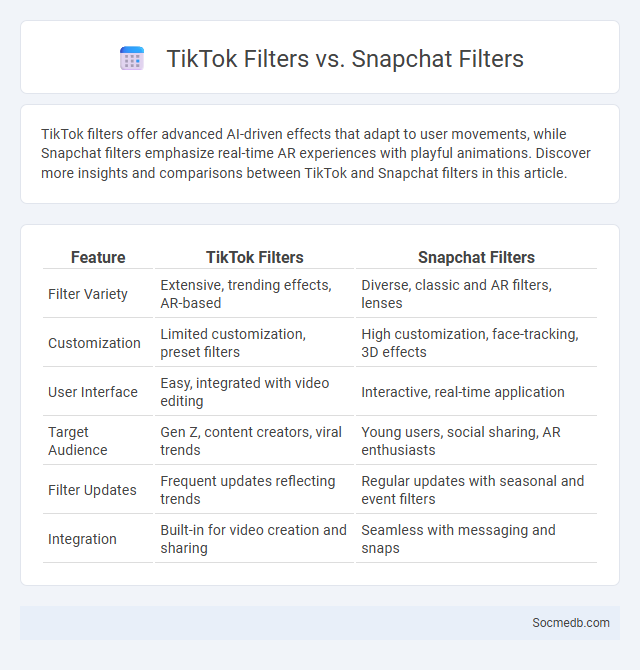
Photo illustration: TikTok Filters vs Snapchat Filters
TikTok filters offer advanced AI-driven effects that adapt to user movements, while Snapchat filters emphasize real-time AR experiences with playful animations. Discover more insights and comparisons between TikTok and Snapchat filters in this article.
Table of Comparison
| Feature | TikTok Filters | Snapchat Filters |
|---|---|---|
| Filter Variety | Extensive, trending effects, AR-based | Diverse, classic and AR filters, lenses |
| Customization | Limited customization, preset filters | High customization, face-tracking, 3D effects |
| User Interface | Easy, integrated with video editing | Interactive, real-time application |
| Target Audience | Gen Z, content creators, viral trends | Young users, social sharing, AR enthusiasts |
| Filter Updates | Frequent updates reflecting trends | Regular updates with seasonal and event filters |
| Integration | Built-in for video creation and sharing | Seamless with messaging and snaps |
Introduction to Social Media Filters
Social media filters enhance your photos and videos by applying real-time effects that transform appearances or add creative elements. These filters utilize augmented reality technology to modify facial features, adjust lighting, or overlay graphics, improving engagement and visual appeal. Understanding how filters influence user interaction can help you create compelling content that stands out across platforms like Instagram, Snapchat, and TikTok.
Overview of TikTok Filters
TikTok filters enhance your videos by applying dynamic effects such as color adjustments, augmented reality overlays, and facial recognition enhancements. These filters enable creative expression and help increase viewer engagement by making content visually appealing and unique. Using TikTok filters strategically can boost your visibility on the platform through trends and viral challenges.
Deep Dive into Snapchat Filters
Snapchat filters leverage augmented reality technology to overlay digital effects on users' faces and environments, enhancing engagement and creativity. These filters use facial recognition algorithms and 3D mapping to track facial movements in real-time, creating immersive user experiences that drive higher content interaction rates. Brands utilize Snapchat filters for targeted marketing campaigns, boosting brand visibility among younger demographics by integrating interactive elements and geolocation features.
TikTok vs Snapchat: Filter Technology Comparison
TikTok employs advanced AI-driven filter technology that leverages machine learning algorithms to create highly personalized and immersive augmented reality effects, enhancing user engagement through interactive content. In contrast, Snapchat's filter technology, powered by Snap's Lens Studio, offers robust real-time facial recognition and 3D tracking capabilities, enabling dynamic and creative lenses that respond instantly to user expressions and environments. While TikTok excels in algorithmically tailored visual effects optimized for viral content, Snapchat prioritizes real-time interactivity and playful user experiences, making both platforms leaders in innovative social media filter technology.
User Experience: Filters Across Platforms
Filters across social media platforms enhance user experience by enabling personalization and creative expression, significantly increasing engagement metrics such as time spent and post interactions. Instagram's AR filters and Snapchat's face lenses utilize advanced computer vision algorithms to deliver seamless real-time effects, encouraging content sharing and community building. Consistent filter updates and platform-specific customization options drive user retention and distinguish each social media environment in a competitive digital landscape.
Comment Section Influence on Content Creation
The comment section significantly shapes content creation by providing real-time audience feedback that creators use to refine topics, tone, and style. Analyzing user comments helps identify trending interests and emerging community needs, driving more targeted and engaging content strategies. This interactive feedback loop enhances user engagement and fosters a sense of community around social media platforms.
Engagement: Filters vs Comment Interaction
Engagement on social media significantly varies between the use of filters and comment interactions, with comment interactions fostering deeper user involvement through direct communication and personalized responses. Filters, while visually appealing and widely shared, primarily enhance user experience by increasing content visibility and attracting casual interactions. Data shows that posts generating active comment discussions often achieve higher retention rates and algorithmic promotion compared to those solely boosted by filter effects.
Virality: The Role of Filters and Comments
Filters enhance content virality by allowing users to customize and visually improve their posts, making them more engaging and shareable across platforms like Instagram and TikTok. Comments boost virality by fostering community interaction, increasing post visibility through algorithmic prioritization on Facebook and Twitter. Together, filters and comments create a dynamic environment that amplifies user engagement and drives exponential content spread.
Privacy and Safety: Filters vs Comment Moderation
Filters enhance privacy by automatically detecting and blocking inappropriate content, reducing user exposure to harmful material on social media platforms. Comment moderation complements filters by allowing human review and context-based decision-making, ensuring a safer and more respectful online environment. Combining both approaches maximizes protection against cyberbullying, hate speech, and spam while preserving user engagement.
Conclusion: The Future of Filters and Comment Sections
Social media filters and comment sections are evolving with advanced AI technologies enhancing user experience and content moderation. You can expect more personalized, context-aware filters that maintain authenticity while offering creative expression. Improved comment moderation tools will foster healthier online communities by reducing toxicity and promoting meaningful interactions.
 socmedb.com
socmedb.com